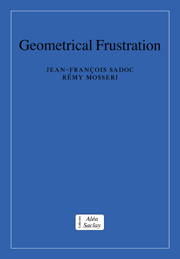Book contents
- Frontmatter
- Contents
- Preface
- 1 Introduction to geometrical frustration
- 2 Ideal models
- 3 Finite structures
- 4 Decurving and disclinations
- 5 Hierarchical polytopes
- 6 Some physical properties
- 7 Periodic structures with large cells
- 8 Quasiperiodic order and frustration
- A1 Spaces with constant curvature
- A2 Quaternions and related groups
- A3 Hopf fibration
- A4 Polytopes and honeycombs
- A5 Polytope {3, 3, 5}
- A6 Frank and Kasper coordination polyhedra
- A7 Quasiperiodic tilings: cut and projection
- A8 Differential geometry and parallel transport
- A9 Icosahedral quasicrystals and the E8 lattice
- Bibliography
- Index
4 - Decurving and disclinations
Published online by Cambridge University Press: 06 January 2010
- Frontmatter
- Contents
- Preface
- 1 Introduction to geometrical frustration
- 2 Ideal models
- 3 Finite structures
- 4 Decurving and disclinations
- 5 Hierarchical polytopes
- 6 Some physical properties
- 7 Periodic structures with large cells
- 8 Quasiperiodic order and frustration
- A1 Spaces with constant curvature
- A2 Quaternions and related groups
- A3 Hopf fibration
- A4 Polytopes and honeycombs
- A5 Polytope {3, 3, 5}
- A6 Frank and Kasper coordination polyhedra
- A7 Quasiperiodic tilings: cut and projection
- A8 Differential geometry and parallel transport
- A9 Icosahedral quasicrystals and the E8 lattice
- Bibliography
- Index
Summary
Disclinations
A disclination is a defect involving a rotation operation, as opposed to the more familiar dislocation, which is associated with a translation given by its Burgers vector (Friedel 1964). For this reason, this defect, introduced by Volterra at the beginning of the twentieth century in his description of a continuous solid medium, is sometimes called a rotation-dislocation. A disclination can be generated by a so-called ‘Volterra’ process, by cutting the structure along a line and adding (or removing) a sector of material between the two lips of the cut. In two dimensions, this defect is point-like, while it is linear in three dimensions. The two lips of the sector should be equivalent under a rotation belonging to the structure symmetry group in order to get a pure topological defect confined near the apex of the cut (Kléman 1983).
A simple example of disclinations: wedge disclinations in two dimensions
It is possible to describe this defect, and the induced deformation, as a concentration of curvature (figure 4.1). This will be argued, in §4.4, from a differential geometry analysis, but it is possible, in two dimensions, to describe this relation more simply. Let us first do the Volterra construction with a sheet of paper. We first cut it along a straight segment up to its centre. Then, upon rotating around this centre, we can either add or remove a sector, and then glue again along the lips of the cut.
- Type
- Chapter
- Information
- Geometrical Frustration , pp. 57 - 99Publisher: Cambridge University PressPrint publication year: 1999

